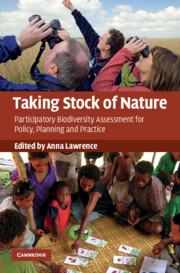Book contents
- Frontmatter
- Contents
- List of contributors
- Acknowledgements
- 1 Introduction: learning from experiences of participatory biodiversity assessment
- 2 Monitoring and assessment of biodiversity under the Convention on Biological Diversity and other international agreements
- 3 The Millennium Ecosystem Assessment: a multi-scale assessment for global stakeholders
- 4 Conservation of biological diversity in El Salvador shade coffee: the importance of taxonomic capacity for participatory assessments
- 5 Taking stock of nature in species-rich but economically poor areas: an emerging discipline of locally based monitoring
- 6 Researching local perspectives on biodiversity in tropical landscapes: lessons from ten case studies
- 7 Participatory resources monitoring in SW China: lessons after five years
- 8 Forest inventory in Nepal – technical power or social empowerment?
- 9 Perceptions of landscape change in British Columbia's Northwest: implications for biodiversity and participatory management
- 10 How thousands planned for a billion: lessons from India on decentralized, participatory planning
- 11 Inside monitoring: a comparison of bird monitoring groups in Slovenia and the United Kingdom
- 12 The personal and political of volunteers' data: towards a national biodiversity database for the UK
- 13 Improving forest management through participatory monitoring: a comparative case study of four community-based forestry organizations in the Western United States
- Index
- References
8 - Forest inventory in Nepal – technical power or social empowerment?
Published online by Cambridge University Press: 06 December 2010
- Frontmatter
- Contents
- List of contributors
- Acknowledgements
- 1 Introduction: learning from experiences of participatory biodiversity assessment
- 2 Monitoring and assessment of biodiversity under the Convention on Biological Diversity and other international agreements
- 3 The Millennium Ecosystem Assessment: a multi-scale assessment for global stakeholders
- 4 Conservation of biological diversity in El Salvador shade coffee: the importance of taxonomic capacity for participatory assessments
- 5 Taking stock of nature in species-rich but economically poor areas: an emerging discipline of locally based monitoring
- 6 Researching local perspectives on biodiversity in tropical landscapes: lessons from ten case studies
- 7 Participatory resources monitoring in SW China: lessons after five years
- 8 Forest inventory in Nepal – technical power or social empowerment?
- 9 Perceptions of landscape change in British Columbia's Northwest: implications for biodiversity and participatory management
- 10 How thousands planned for a billion: lessons from India on decentralized, participatory planning
- 11 Inside monitoring: a comparison of bird monitoring groups in Slovenia and the United Kingdom
- 12 The personal and political of volunteers' data: towards a national biodiversity database for the UK
- 13 Improving forest management through participatory monitoring: a comparative case study of four community-based forestry organizations in the Western United States
- Index
- References
Summary
Community forestry in Nepal has long been considered a leading model of participatory forest management, whereby the state hands over national forest to be managed by local Community Forest User Groups (CFUGs). This development has been well documented (Hobley, 1996; Poffenberger, 2000; Ojha et al., 2006) with particularly keen attention to the social issues of organization, livelihoods impact and equity. However, the trend in Nepal follows a global tendency, as attention has shifted more recently to the technical details of forest management (Lawrence, 2007). Furthermore, as participatory approaches to natural resource management proliferate, initial enthusiasm has been tempered by the challenges of both scaling up participatory practice amongst the stakeholders who govern and use the resources (Sukwong, 1998) and developing the policy and institutional framework to support such approaches.
In this chapter we explore the negotiation of responses to both these shifts, through the process of developing and implementing the government-approved forest inventory guidelines for community forestry in Nepal (Ministry of Forests and Soil Conservation, 2000; Department of Forests, 2004). We focus on the process and how the results were experienced by different stakeholders – national and district staff from the Department of Forests, members of non-governmental organizations (NGOs) representing civil society, and CFUGs. We examine the knowledge, roles and involvement of these stakeholders in the development of the inventory guidelines.
- Type
- Chapter
- Information
- Taking Stock of NatureParticipatory Biodiversity Assessment for Policy, Planning and Practice, pp. 165 - 184Publisher: Cambridge University PressPrint publication year: 2010
References
- 3
- Cited by



